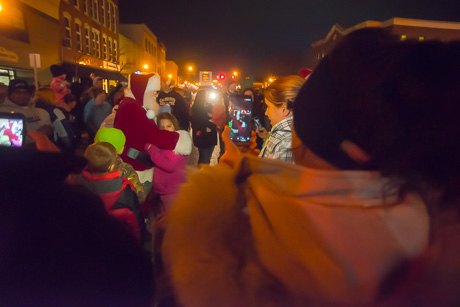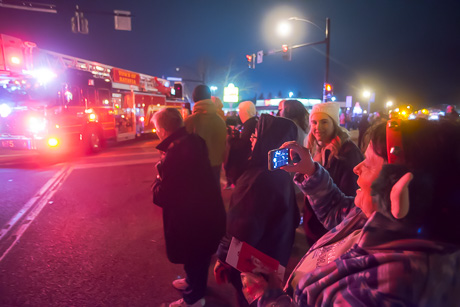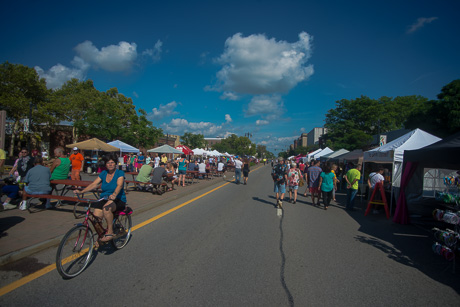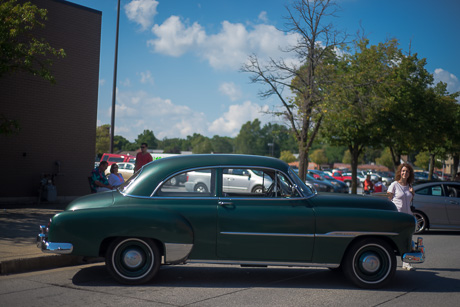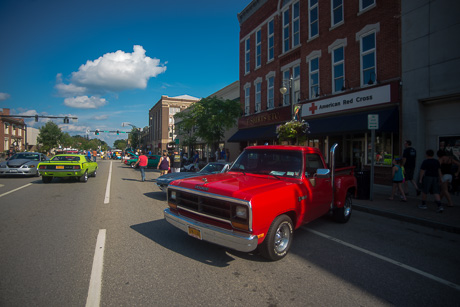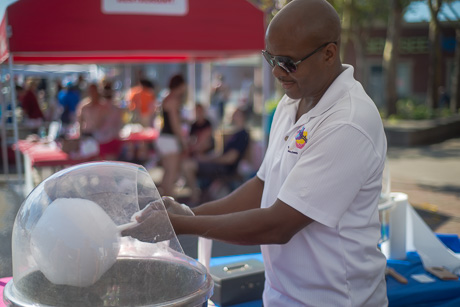downtown
LG Hochul shops local in Batavia
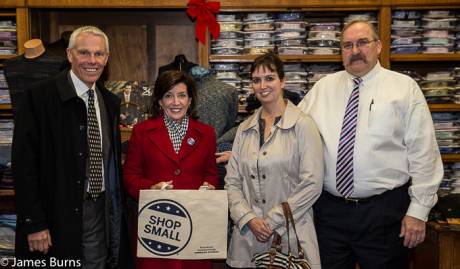
Lt. Gov. Kathy Hochul was in town today for a meeting with local business organizations. After her meeting, Tom Turnbull, president of the Genesee County Chamber of Commerce, and Laurie Oltramari, director of the Batavia Business Improvement District, took Hochul for a shopping trip on Main Street to support the campaign to “Shop Small."
First stop was Charles Men’s Shop.
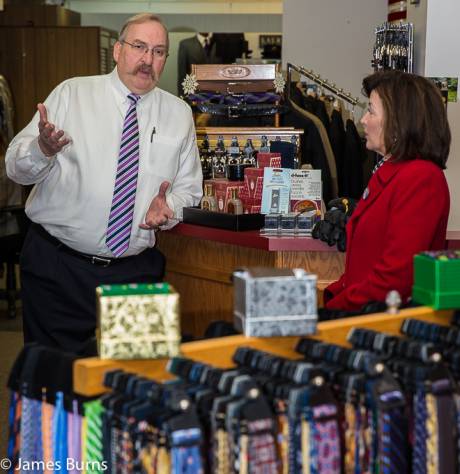
David Howe, the owner of Charles Men’s Shop, explained to Hochul that he was skeptical of “Shop Small” when he heard about it but it has been rather successful the last two years. An encouraging discussion about the strength of the town and local business ensued but was interrupted by Hochul because, like most who go into the Men’s shop, her eye was drawn to the tie rack. I will not divulge what happened after that because I do not want to ruin the surprise of William Hochul’s Christmas present.
Off to Adam Miller Toy and Bicycle.
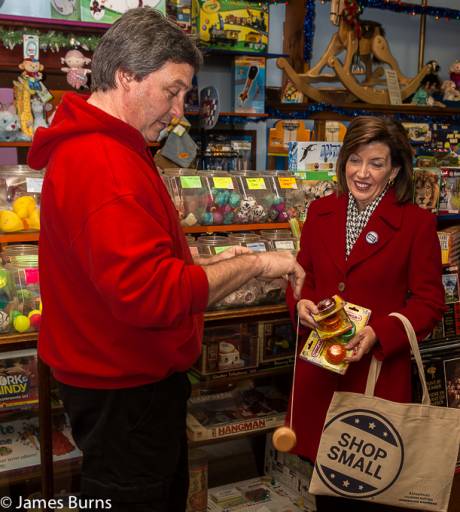
Miller’s is another classic local business with unique items and something for everyone. Hochul asked store owner John Roche what the hot item was this year and the answer was the Yo-Yo, American made no less.
Next stop was p.w. minor
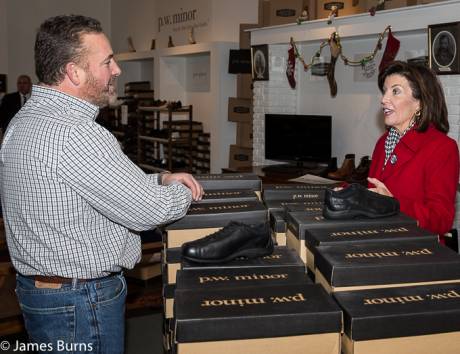
p.w. minor is a company on the move. Andrew Young, the president of p.w. minor, light ups when Hochul asks him how things are going. Apparently they are going well, very well. Young is delighted with the progress the shoe manufacturing business is making and says he's very happy with the local work force.
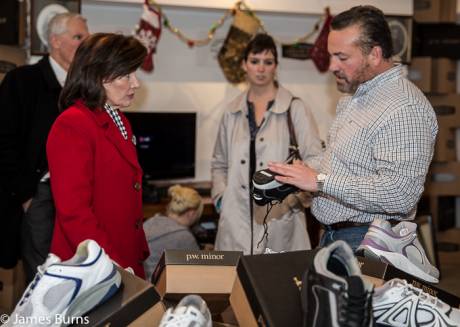
Young explains to Hochul some of the technology in the athletic shoes that is unique to p.w. minor.
The last stop was Main Street Pizza. It's another small business success -- doubling in size, taking over the store next to it. Inside, the popular pizzeria is celebrated with pictures and wall murals mixing up the past and present. Owner Vic Marchese is pictured in his red apron.
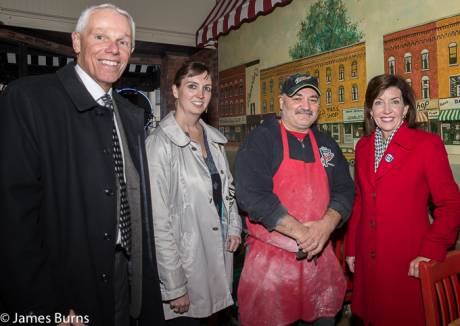
Tired of reading all the bad news, Larry's co-owner turning the tables and serving free meals for Thanksgiving
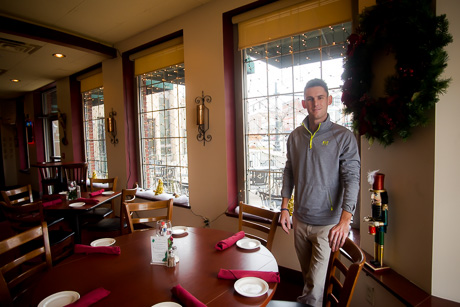
There's been too much bad news in the world recently, so Brenden Mullen, co-owner of Larry's Steakhouse, on Main Street, Batavia, decided he wanted to do something good.
Larry's will be open from 4 to 8 p.m. Thanksgiving Day serving free meals to "anybody and everybody" who wants to stop in.
The meals will include turkey, mash potatoes and gravy, stuffing, squash and cranberry sauce along with a slice of pumpkin pie.
All for free.
"Somebody very dear to me, touched my life, had a positive impact and made me want to better myself in any way I can," Mullen said. "I thought it might be a step in the right direction."
Word has spread quickly on social media, Mullen said, and just today he got a touching call from an administrator at Batavia High School who said a student who had been wondering what he would do on Thanksgiving, with no place else to go, heard about the community meal and now he plans on being at Larry's.
That really touched Mullen, he said. It's hard to believe in this day and age a high school student would need some place to go on Thanksgiving Day, but there are people in our community with all kinds of needs, he said, and perhaps his gesture will help a few people out.
He just came up with the idea Saturday, enlisted the chef to help, and started getting things organized. He doesn't know what to expect and said additional volunteers to help are welcome.
"I thought it would be a good way to do something good for the community," Mullen said. "Like I said, I just get sick of reading the news, turning on the TV, and it's nothing but bad news anymore, so I wanted to give people a reason to smile and feel good about something."
Art Ah La Carte marks move downtown with Brush Out Cancer fundraiser

Kimberly Yasses Argenta has moved Art Ah La Carte from Harvester Avenue to Downtown Batavia, into a storefront on Jackson Street.
She moved the art studio and classroom space because she needed more space, she said, and she thought the location would give her better exposure.
"Already, people have come in off the street, so that's a good thing," Argenta said.
She also thought it would be beneficial to be part of the Business Improvement District and enjoy those promotional opportunities.
This Friday and Saturday she is hosting "Brush Out Cancer," an event to raise funds for the American Cancer Society.
Friday is an art show, vendors' auctions and a 50/50 raffle. On Saturday, from noon to 1:30 p.m., there is Kids Paint. The cost is $30 and pre-registration is required (call (585) 245-1655). And in the evening, starting at 6, Monet and Merlot, which costs $45 and includes refreshments, though if you want wine, you need to bring your own bottle. There will be a wine tasting. Saturday evening's event also includes auctions and a 50/50 raffle.
The fundraisers are in memory of Argenta's mother, Mickey Yasses, who passed away in December, 2013.
BID director seeks change in overnight parking law for Downtown
Downtown business owners, especially bar owners, want to see a change in the restrictions on overnight parking Downtown, Laurie Oltramari, new executive director of the Business Improvement District, told City Council members during Monday's meeting.
Oltramari spoke during the open public comments portion of the agenda.
She's asking that the city adjusts the parking law, which prohibits on-street parking and parking in public lots from 2 a.m. to 6 a.m., during the spring, summer and fall to allow bar patrons to leave their cars overnight if they decide that's the best option.
"The bar owners came to me because they felt their patrons are being penalized for leaving cars after drinking (at the bar)," Oltramari said. "When you have to make that choice between moving your car because you might get a ticket or leaving it when you're intoxicated or a little tipsy, you might make that wrong choice."
City Manager Jason Molino said he became aware of the request for the change for the first time when Oltramarie raised it during the meeting. He said with the city about to embark on a new comprehensive planning process, that process is the appropriate venue for addressing the issue.
"I think there is positives and negatives with it," Molino said. "It does create a maintenance issue at times. I really don't know if the restriction on overnight parking really does or doesn't create a problem. I mean, it's been in existence and I don't think it's prevented anything from happening."
One of the primary reasons for the restriction is to make snow removal easier during the winter, which is why Oltramari is asking for a seasonal adjustment, not a blanket, year-round change.
Oltramari presented a list of other small cities in Upstate New York and their various parking restrictions, many of which have seasonal parking laws, including Fulton, Geneva, Hornell (restricted overnight in the fall for leaf cleanup), North Tonawanda, Norwich, Ogdensburg, Olean (based on snowfall levels) and Rome.
Molino said he's spoken with many of his colleagues throughout the state about the issue and it's not that straightforward.
"They say, 'when you find a solution, let us know,' " Molino said.
As for going through the comprehensive plan process, Oltramari said something should be done sooner rather than later.
"I think it can be addressed with the comprehensive plan, but that's a long process," Oltramari said. "Why would we want to wait for that when this is the right choice in the meantime?"
Good things for Batavia expected to flow from downtown microbrewery
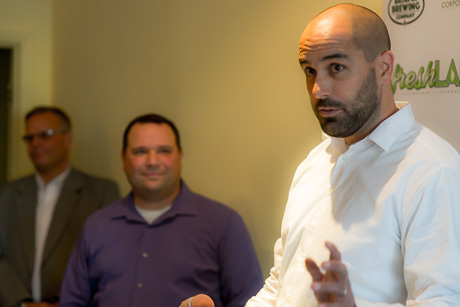
Matt Gray remembers the old J.J. Newberry's Downtown, with its creaky floors, dusty inventory and a lunch counter he would saddle up to next to his grandmother to enjoy a hot dog.
Now he owns that building, but his ambition far exceeds nostalgia. It's about revitalization and doing his part to bring vibrancy and economic growth back to his community.
Gray, along with partners Jon Mager and Matthew Boyd, will be the owners of the anchor tenant in an ambitious project backed by the Batavia Development Corp., Genesee County Economic Development Corporation, and Rural Development/USDA to help aspiring restaurant owners get a start in Downtown.
The partners are creating Batavia Brewing Company, a new microbrewery at 109 Main St., Batavia.
The location will also be known as freshLAB, a restaurant incubator where entrepreneurs with great ideas for unique menu items sourced mostly with local and regional ingredients can see if they can turn their food concepts into thriving businesses.
Mager said the ambition for the project is rooted in the fact that he and Gray grew up in Batavia, are businessmen in this community, are raising families here and want to see their community thrive.
"We wholeheartedly believe Batavia is a great place to live, work, play and raise a family," Mager said. "By joining the ranks of the many great places to eat and drink Downtown, we hope to be part of a complete and full resurgence and revitalization that is attracting people back to Downtown."
Gray said they picked a downtown location because that would generate the greatest economic impact, both for other restaurant and bar owners and for themselves.
"There were a lot of other pluses on a lot of other sites, including parking, but (what) it came down to, is we believe in the clustering effect," Gray said. "There are so many good restaurants and so much good nightlife already down in this area. Adding more to it is only going to make each one of us healthier. By going off on our own, we're going to have to fight uphill to trying to get people to come to us."
Mager and Gray, who got his start in food business ownership with Matty's Pizzeria and currently own's Alex's Place along with restaurants in Southern states, first started talking about opening a brewery in 2013. In 2013, Mager completed training with the American Brewers Guild.
At the same time, Julie Pacatte and the BDC board were looking at all this data saying too much restaurant and bar spending by local residents -- some $12 million -- was being spent outside of Batavia. People wanted more food choices locally. And there were a number of people who would come to the BDC for assistance in starting restaurants, but just didn't have the wherewith all to pull it off. So this incubator idea, which has been successful in other markets, started forming.
Pacatte heard about Mager and Gray's ambitions and recognized the possibility of a partnership.
"We want those dollars to say here," Pacatte said. "We want a reason for people to be eating and drinking in Downtown Batavia, more reason to do that. We want to offer a product that really ties our commerce, our downtown businesses to our agriculture community."
In a survey, the vast majority of respondents said they want healthier food choices in Batavia, they want more ethnic food (Millennials especially, marketing data shows, go for Far Eastern cuisines and spicier choices), and diners want more seafood.
"We're hoping that in this concept and in this project, that we're able to draw some of the folks in who can create some of those plates and meals and sandwiches or salads, that will be able to invent those kinds of meals and lunches and dinners and breakfasts here in Batavia," Pacatte said.
Rural Development is kicking in more than $67,000 in grants to provide equipment and furnishings for the "dining hall" element of the facility, that will be a shared space between the brewery and the food vendors.
Steve Hyde, CEO of GCEDC, praised Gray and Mager for their foresight and willingness to take a risk, as entrepreneurs, to start a new business concept in their own community that will help their own community. Batavia is on the rebound, Hyde said.
"We have the innovation economy in our community now, higher-paying jobs, bigger-paying jobs, so our kids (can) stay here, come back home, and guess what, it makes this place a great place live, work and play and opportunities like this are going to make this happen even more," Hyde said. "It's really a great way to shine up the apple here in the city."
He said Mager and Gray are visionaries.
"It's so rewarding to us to have our local guys step up to the plate, invest in their community, and do what they're good at, 'cause this isn't new news for these guys," Hyde said. "This is right in their wheelhouse and they'll make it a great success."
Microbrewery planned for Downtown Batavia as part of new restaurant incubator

Aspiring restaurant owners are going to get a unique opportunity to start their own businesses in a Downtown Batavia location that will be anchored by a new microbrewery, economic development officials will announce tomorrow.
A press conference is scheduled at 109 Main St., Batavia, at 3:45 p.m. to announce plans for freshLAB and the Batavia Brewing Company.
The freshLAB concept is borrowed from other successful restaurant incubators in larger markets, such as Dallas, Denver and Los Angeles.
Batavia Brewing will be owned by a current local restaurant owner. Attempts to reach that owner to confirm his participation have been unsuccessful.
The announcement from officials of the press conference, however, makes clear a brewery is part of the plan (the logo included with the announcement is at the top of this post).
The concept of the restaurant incubator will be fully explained tomorrow, but Julie Pacatte, economic development coordinator for Batavia Development Corp. said the idea grew out of what the BDC board has observed for a number of years. The board had to turn down several requests to provide low-interest loans to proposed restaurants because of either undercapitalization or inexperienced aspiring owners.
With the incubator concept, aspiring restaurant owners can get started with a smaller initial investment and there will be advisors available to help them plan their concept, get up and running, manage the operations and hopefully, eventually, expand into a bigger, stand-alone location.
"Opening a restaurant is a big undertaking," Pacatte said, "60 percent fail within the first two to three years. This will provide those owners with a more affordable space and more coaching and guidance."
The location, 109 Main St., is the former Newberry's building. Most recently it was the location of T-Shirts Etc. and the Red Cross. It was previously the location of Main Street Coffee. Previous owner Ken Mistler has sold the building. The new owner will be announced tomorrow.
Also participating in the press conference is the Rural Development division of the U.S. Department of Agriculture. The USDA will provide grant assistance for the restaurant incubator.
Part of the concept of the incubator is that aspiring restaurant owners must source most of their ingredients from farms from throughout the WNY region. The restaurant/food station concepts must also be unique to Batavia. The menu needs to be a different concept with offerings that vary from what's available in restaurants currently.
Part of the driver for creating the incubator is marketing surveys that show a lot of the entertainment and dining dollars spent by Batavia residents is flowing out of the county. Economic development officials hope to create a stronger cluster of restaurants in Batavia to help keep more of those dollars in the local community.
Photo: New awning being installed on patio at City Slickers

After a couple of years of considering his options, City Slickers owner Ken Mistler has settled on a design for an awning over the patio of his Downtown restaurant. The steel beams for the awning are being installed today and the awning should be completed in about a week. While the patio will be open, it will be heated, Mistler said.
New p.w. minor store downtown designed to make it easier for you to buy locally made shoes
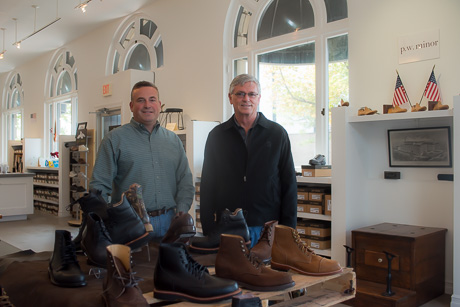
The product is Batavia made, so it should be Batavia sold, the way Andrew Young and Pete Zeliff see it, so they've opened up a downtown retail store for p.w. minor's shoes.
Not just seconds, but the full product line.
"That is something totally different from what the store was known for before," said Zeliff, speaking of p.w. minor's outlet at the factory on Treadeasy Avenue. "The store was always known for seconds and it was a discount store. We still have the factory seconds and all that, but we also offer everything we sell. All of our number one product is here in the store."
Young and Zeliff have been aggressive about growing the 148-year-old Batavia-founded business since acquiring it in August, 2014. They're moving manufacturing jobs from China back to Batavia and have hired top-tier professional product development specialists and designers.
As some of those new products are brought to market, they will be introduced in the Batavia store, Young said.
"It's neighbors making the product you're buying," Young said. "It couldn't be any neater."
The company has rented the retail space at 97 Main St. only through January. Young and Zeliff want to see how it goes before making a longer-term commitment. The store will be open Tuesdays through Saturdays, starting today.
While they are continually asked by people in the community where they can go to buy p.w. minor shoes, they aren't often making it over to 3 Treadeasy Ave. The owners hope the new location is easier to find and more top of mind.
"I've lived here for 60 years and I didn't know where 3 Treadeasy Ave. was," Zeliff said. "So we'll try being here on Main Street, being in front of people and reminding people as they walk by that p.w. minor is here, it's hometown, it's hometown jobs."
For previous p.w. minor coverage, click here.


Photos: Wine Walk 2015 in Downtown Batavia
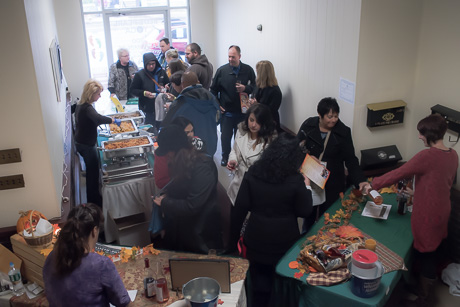
Nearly 700 tickets were sold to this year's wine walk in Downtown Batavia, with a couple of dozen businesses participating. Rain didn't dampen the good times.
Top photo is the service area for The Batavian in the entryway of the Masonic Temple building. Thanks to Dee Neilans, Lisa Ace and Lucie Ann Griffis for serving the food and wine, and special thanks to Dibble Family Center for catering our food service.
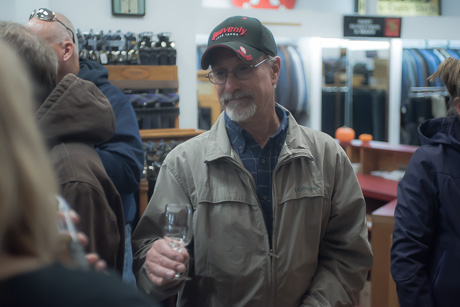
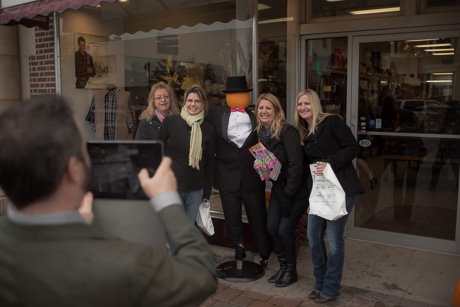

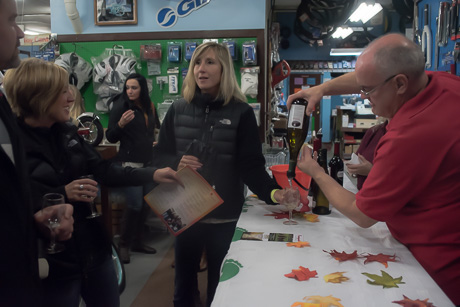
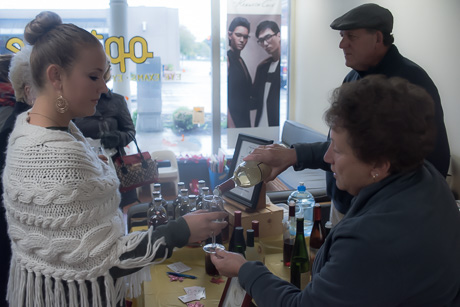
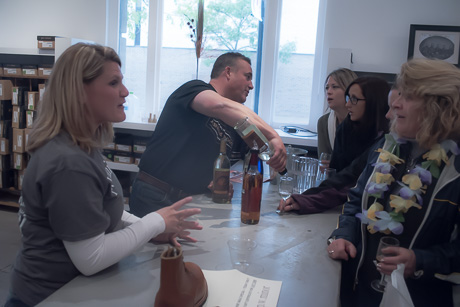

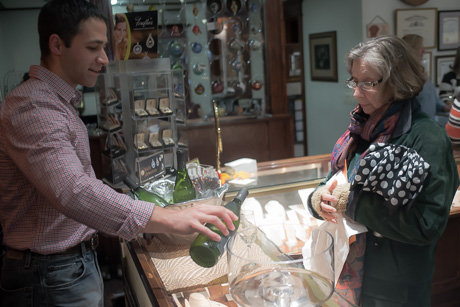


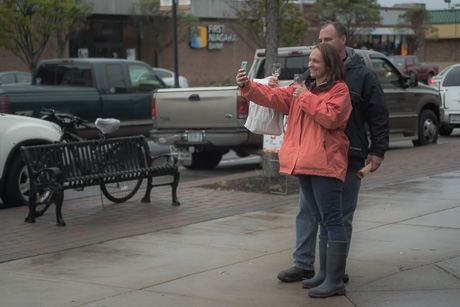
Photo: Main St. Pizza Company expanding
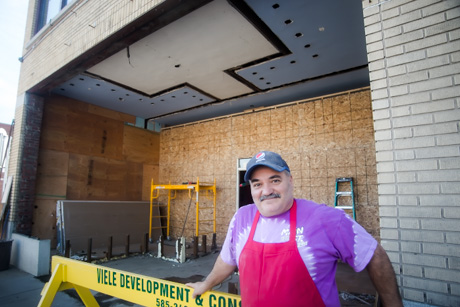
Vic Marchese, owner of Main St. Pizza Company, on East Main Street, Batavia, stands in front of the opening of the commercial space next to his business where workers are busy remodeling so Marchese can add more space to his popular restaurant.
The front part of the restaurant will feature a sliding window system, called a nana system, that will allow open-air dining when weather permits, but a closed dining area when it gets cold.
With his plans recently approved, Marchese just ordered the windows, which will take six to eight weeks to arrive. Marchese is optimistic the new space will open in January.
The restaurant will expand by about 2,000 square feet and include additional interior dining room space, as well. The dining room and the pick-up counter will have separate entrances, which will help people get in and out of the restaurant faster.
Marchese is also expanding the kitchen.
Photo: Hometown Heroes
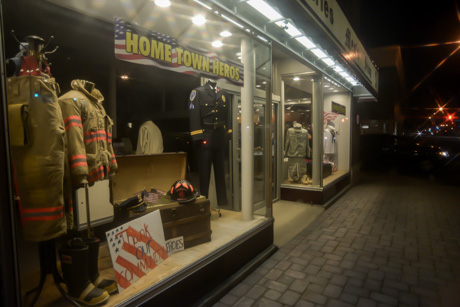
Charles Men's Shop always has interesting and attractive window displays, but the clothing featured are usually the in-season fashions for the sharp-dressed man. For the past several weeks, the store has been featuring a line of clothing it doesn't even carry -- the uniforms of heroes. One window is dedicated to hometown heroes -- police and fire -- and the other to the U.S. military. Don Brown said he and Dave Howe saw the display as a way to give back to the community by showing appreciation for the men and women who put their lives on the line to keep us safe and free.
Photo: High lift outside City Church
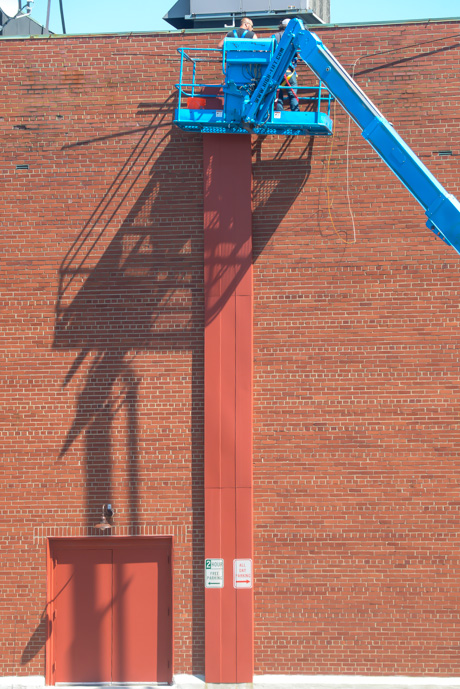
Workers outside the City Church building on East Main Street this afternoon. Pastor Marty Macdonald said the floodlights are being replaced with LEDs and crews also do some masonry maintenance.
Rock star rocks Center Street

Joey Belladonna, lead singer of the metal band Anthrax and native of Oswego, brought his cover band Chief Big Way to Center Street Smoke House on Friday night. The room was packed with fans as the trio, with Belladonna on drums, powered through big rock hit after hit. Tom Mazurkiewicz, who became friends with Belladonna after meeting him at Darien Lake, helped arrange the appearance.







You can Chalk the Walk during Summer in the City
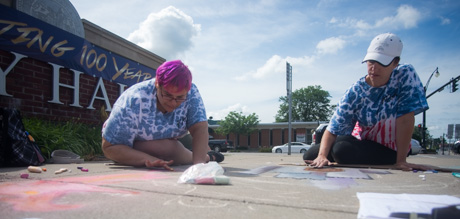
Gena Korn and Jennifer Gray are creating a bit of chalk artwork in front of City Hall this morning to help promote GO ART!s Chalk the Walk event Aug. 15 during Summer in the City. (Photo by Howard Owens).
Press release:
GO ART! will be presenting the second annual Chalk the Walk on Aug. 15th from 9 a.m. - 6 p.m. during Summer in the City. Artists, professional and amateur and young and old, will be able to purchase a square section of concrete by the City Center to decorate with chalk pastels. There will also be a children’s section for fun scribbling.
Using materials available, artists will follow the theme “GO ART!...Where does art take YOU?” to create inspired pieces for a crowd of more than 2,000 people. Prizes will be awarded to those whose pieces are most outstanding. Adult First Prize will be $250. People’s Choice Award will be a $20 Alex’s Place gift card, two T-shirts, and two mugs. The Youth Prize will be a basket of goodies worth over $50.
A jury will select the winners for Adult First Prize and the Youth Prize. People’s Choice will be chosen by the general public by way of donation voting (ie: the art piece that receives the most donation money will be the People’s Choice winner). All donations collected for the People’s Choice Award will go to funding GO ART! youth programs.
To sign up for this event, people need to register online at http://www.goart.org/chalk-the-walk/ or register in person at GO ART!, 201 E. Main St., Batavia, from Tuesday through Friday between the hours of 9 a.m. and 4 p.m. People can also sign up and pay the day of the event but it is highly encouraged to do so ahead of time.
Remember, no one is officially registered until payment is received. Fees are $20 for adults (18+) and $10 for Youths (17 & under). Every registered artist will receive a box of chalks and a drink to get them started. There will be a chalk swap area where people can trade out their chalks for other colors they need. Artists are encouraged to bring their own chalks as well.
It is important to assure that each artist and their work, as well as the event itself, is respected, so there will be rules and regulations. These are available on the Web site at athttp://www.goart.org/chalk-the-walk/.
People can find updates on Chalk the Walk by going to the Web site:http://www.goart.org/chalk-the-walk/ or by following Chalk the Walk on Facebook:https://www.facebook.com/BataviaStreetPaintingFestival.
Please consider participating! It's going to be a great event! If you have any questions, please feel free to phone 585-343-9313 or visit americorps@GOart.org.
Chance of rain, so tonight's Jackson Square concert moved indoors
Tonight's Jackson Square concert, featuring Penny Whiskey, is being moved to City Centre because there may be rain.
The show is at 7 p.m.
Batavia's Millennial challenge
The U.S. Census Bureau put out a press release and the national media ate it up: There are now more people living in the United States who are classified as Millennials than there are Baby Boomers.
The Democrat & Chronicle got into the act by pointing out Millennials now outpace Baby Boomers in Monroe County.
There’s been no similar coverage in Erie County, but Buffalo has enjoyed a reputation for the past couple of years as one of the major cities young adults are helping to revitalize.
So where does that leave Genesee County?
Not on par, it seems.
While nationally, there are 83.1 million Millennials, comprising a quarter of the U.S. population, and the number of Baby Boomers has slipped to 75.4 million, the post-war cohort still rules the roost in the Batavia Micropolitan Area.
According to the Census Bureau Web site, there are 15,422 Baby Boomers locally compared to 14,670 Millennials.
Is Genesee County’s lagging Millennial population a trend that's important?
Absolutely, say those with the jobs related to the area’s development and growth.
“You definitely want to have Millennials in a community,” said Felipe Oltramari, the county planning director. “The next generation will create the jobs and opportunities for future generations to be here. As they become players with purchasing power, we want to make sure they are living here and they’re bringing more buying power and creating more jobs and running our community. From an economic development perspective, and social perspective, you want people here from all sorts of generations.”
The window of opportunity to anchor a small town with Millennials may be closing shortly, according to William Fulton, director of the Kinder Institute for Urban Research at Rice University in Houston, Texas.
And it’s a critically important issue for the future of small cities.
“Most people settle down by age 35, and usually don’t move from one metro area to another after that,” Fuller wrote in an article for Governing.com. “And the demographic group behind the Millennials is a lot smaller. Just like Baby Boomers, the preferences of the Millennials will drive our society for two generations. They’re making location decisions based on their idea of quality of life. And they’re going to make all those decisions in the next few years -- by the time they’re 35.”
The good news, according to Fuller, is even if time is short, the goal is obtainable for small cities.
“Even Millennials … want to live near their families and near where they grew up, meaning that if you can create interesting places, they’re likelier to stay,” Fuller wrote. “And you don’t need the endless hip urban fabric of New York or D.C. to compete. You just need a few great neighborhoods for people to live and work in. For most cities, that’s an achievable goal.”
Interesting places, amenities, activities, culture and the opportunity to interact socially, these are the things planners say Batavia needs to retain and attract Millennials.
“I try to drive this point every time I speak,” Oltramari said. “This generation moves first and then finds a job. If you look, there are jobs here and available, but they want to be where their peers are.”
So how do we create an environment where Millennials want to live?
A key word: density.
According to research by Nielsen:
“Sixty-two percent indicate they prefer to live in the type of mixed-use communities found in urban centers, where they can be close to shops, restaurants and offices. They are currently living in these urban areas at a higher rate than any other generation, and 40 percent say they would like to live in an urban area in the future. As a result, for the first time since the 1920s growth in U.S. cities outpaces growth outside of them.”
Tim Tielman, a Buffalo preservationist and development consultant, observed at a Landmark Society talk in 2013 that Batavia is hampering its ability create the kind of economic core that attracts Millennials and like-minded residents with its over-abundance of downtown parking.
"One of the biggest issues every city faces is dead zones," Tielman said. "Batavia has dead zones up and down its streets. Dead zones are devoid of commercial activity. You chain too many dead zones together and you destroy your local community."
When you build your commercial district around the car, the district loses its appeal to pedestrians, and when people walk and interact, commercial activity soars, the feeling of community is pervasive, and social and civic capital grows.
"It isn't cars that make a place a commercial success," Tielman said. "It's a success (based) on how well the human animal can get about certain places. It's what appeals and what stimulates them to walk."
More and more, City Manager Jason Molino said, he’s hearing people talk about walkability. Increasingly, it’s what all communities are after, and something — along with the companion concept bikeability — that Batavia is lacking.
“People want quality-of-life amenities,” Molino said. “People will commute a little bit if you don’t have the jobs in this area if they have the amenities.”
Molino got an immersive experience in the kind of lifestyle amenities that help bring vitality to an urban area. On a vacation day, he and his family visited a couple of the shopping districts in Buffalo and then stopped for dinner at Larkin Square. It was Food Truck Tuesday (video).
Larkin Square, part of what is now known as Larkinville, an area once known as the Larkin District, which is considered Buffalo’s first commercial district, was a rundown industrial warehouse neighborhood. Spurred by a $2 million public-private investment in 2009, the Larkin Building and surrounding cityscape was redeveloped and revitalized. It’s become a hot spot in Buffalo for retail, food and entertainment activity. Tielman was a consultant on the project.
“Two things were obvious to me,” Molino said. “You had people coming to the square right after work, Millennials coming right after work, but you also had the senior population and families — people interested in this kind of quality-of-life amenity with vendors, live music, a pavilion and seating area, and a grass area, and 20 food trucks, all reasonably priced.”
There’s an interesting intersection these days between what Millennials want and Empty-nesters want, Molino noted. They want to get away from the demands of suburban home ownership and the lack of a closely knit community fabric and they seek out walkable neighborhoods with plenty of retail, dining and entertainment options.
That’s what he saw throughout his vacation day with his family in Buffalo.
Steve Hyde’s spent some time recently in Larkinville as well and came away with the same observations.
“It’s a fabulous, vibrant place,” said Hyde, who is the president and CEO of Genesee County Economic Development Center (GCEDC).
Hyde has been spending more time recently working with the City of Batavia to help secure funding and support for the city’s Batavia Opportunity Area, also known at the Brownfield Opportunity Area, or BOA.
The BOA plan is focused specifically on redevelopment of properties that are stalled in the revitalization pipeline in the Downtown area, such as the Della Penna property on Ellicott Street. Moving these projects forward would help advance further Downtown revitalization.
A look around town at all the underused and often dilapidated space might make revitalization feel like a daunting task, and though time is short to attract Millennials, Julie Pacatte, the economic development coordinator for the Batavia Development Corp., isn't feeling any pressure, at least in the sense that revitalization needs to occur before Millennials age out of relocating.
"I think we're fortunate that by the time people reach 35, they tend to move back here with their families," Pacatte said. "They want that smaller-town environment, where they know who's who and they like that feeling of community. We're fortunate it in that way, so no, I don't feel the pressure. I do think we have an opportunity to attract younger people sooner into our community and we're excited about that opportunity. I don't feel the pressure of it, but I certainly want to see something happen in a shorter time frame, in the next five years, in terms of turning some of these sites around."
Since the trend in cities across the country is toward density and mixed use, with greater demand for apartments in downtown areas, Batavia has backed several initiatives to convert underused or unoccupied space in Downtown into apartments, and Pacatte has been right in the middle of it.
She said the new apartments Downtown have certainly proven attractive to Millennials.
Molino agreed.
“All of our marketing studies show there is a demand for this kind of housing in Batavia,” Molino said. “People want to come to our area. It’s a core, central area.”
Part of the plan for Downtown is also creating more office space. Businesses that are founded by Millennials or that hire Millennials need space to relocate and grow, Pacatte said.
"A priority for us is drawing more people Downtown to live, work and shop," Pacatte said. "Millennials are the right target market for our Downtown plan."
While Hyde’s job is to create jobs and stimulate economic growth in Genesee County, Molino’s focus is a little broader. He wants to see Batavia become a better place to live.
He believes Batavia is ideally suited to be a less-expensive alternative to Buffalo and Rochester for Millennials and Empty-nesters, even when they work in the larger neighboring counties.
“With mobility being what it is these days, if you draw a half-hour circle around Rochester and Buffalo, they’re going to intersect in Batavia,” Molino said. “If people at that half-hour distance as a reasonable community, where can they find those amenities? That’s going to be what sells communities to Millennials and Empty-nesters.”
Hyde said what has already been accomplished in Batavia is attracting Millennials. He knows because his daughter, who works in Rochester, and a roommate, who works in Buffalo, rented one of those Downtown apartments.
“They love it,” Hyde said. “Everything is in walking distance. There are restaurants and bars and things for them to do. We need more of that Downtown.”
A place for Millennials to land in Batavia will increase the impact of STAMP (Science, Technology and Advanced Manufacturing Park) if the GCEDC is successful in attracting the kind of high tech, nano tech, advanced materials, solar and bio-manufacturing the park is designed to accommodate. The companies that set up shop in STAMP are going to hire a lot of Millennials who will make good wages and want a lifestyle that is social and active.
Hyde believes Batavia needs to be ready for them, or miss the opportunity to secure future growth.
“We can be a bigger center of economic opportunity,” Hyde said. “We can create a hip, smaller center city with lots of lifestyle choices.”
The BOA is tuned to provide just that kind of boost.
"The opportunity is in front of us," Pacatte said. "We have to make our Downtown more attractive and through these BOA sites, we will really be able to transform the Downtown experience."
BDC releases info on Brownfield Opportunity Area for Batavia
Press release:
Less than a century ago, Batavia’s downtown was bustling with industry, where innovators relocated from New York City to mass produce farm implements to World War II incendiary bombs. These factories employed thousands of workers and took advantage of easy transportation, the railroad and nearby markets. But, the bygone era left a wake of deteriorating buildings, vacant lots and ground contaminants within City limits, a.k.a brownfield sites. Today, City leadership proclaims robust performance-based tax incentives available for the taking to return these underutilized or abandoned locations into vibrant mixed-use places.
In April, the New York Department of State (DOS) officially designated Batavia’s central corridor a Brownfield Opportunity Area (BOA) listing five strategic redevelopment sites. On a parallel track, the City’s local development corporation encouraged Councilmembers to adopt real property tax exemptions and they chased other tax credits to motivate real estate investment. Bold incentives are now in place.
“We could stand by and let these properties continue to decay the neighborhood or do something about it,” City Manager Jason Molino said.
Do something about it, they have. The City has worked to increase its bond rating to A1, turned a multimillion dollar deficit into a balanced budget with capital reserves and secured more than $5,000,000 in grants to improve existing industrial areas, upgrade infrastructure and study the longtime stagnant community.
A Community Improvement Plan was released in 2012 emphasizing an upgrade in housing stock followed by local adoption of real property tax exemptions that offer 12-year tax-bill discounts for converting non-residential buildings into mixed-use spaces. Shortly after, a sizeable $265,000 New York State Department of State BOA grant enabled local activists to grease the skids even further.
“It took four years but, the grant allowed us to hire a consulting team and organize a local Steering Committee to define market opportunities, investigate the ground and write a plan to move our central business corridor into the 21st century,” Molino said. “We know our small city can offer the conveniences and experiences of a larger city, but at an affordable price.”
The challenge was to determine if the real estate community would invest in the area. Now, the market reports and community confidence suggest they will.
The expert-led and community-inspired BOA plan was formally adopted by City Council in June 2014 and handed off to the City’s local development corporation to implement. The Batavia Development Corporation (BDC) immediately retained Harris Beach PLLC, a known deal-maker in the State to guide the efforts.
“It’s funny how the BOA designation appears like a badge of honor,” said Julie Pacatte, BDC coordinator. "It reads like a proclamation from DOS. In truth, it’s bittersweet. Sad we have these blighted areas but happy it sanctions bonus tax credits rewarding investment.”
Gaining access to that tax credit program is a whole different process, according to Pacatte.
The BDC Board authorized cash reserves to extend environmental investigation and to hire Harris Beach and LaBella Associates to prepare the New York State Department of Environmental Conservation Brownfield Cleanup Program (BCP) application. DEC serves as the gatekeeper to request access to the State tax credit program.
“It is a 643-page document enumerating data with compelling narrative to justify access to the program,” Pacatte said. “The BDC Board is clearly determined to advance the BOA plan.”
Unfortunately, their ambitious goal to go to market last year was stalled by expanded data collection, typical land assembly delays and uncertainty with the BCP as it under-went reform during the State’s budget process. Nevertheless, advocates still believe Batavia remains milestones ahead of other communities.
“The BDC’s approach is aggressive and recommended,” said Bob Murray, partner, Harris Beach PLLC. “To enter the BCP prior to marketing the property assures a preferred developer significant refundable NYS tax credits potentially worth up to 64 percent of total costs incurred for remediation, site preparation and new capital expended on that parcel. Not many communities are as proactive and committed.”
The BDC has released its first request for proposals addressing “Ellicott Station” a four-acre downtown redevelopment area that has confirmed acceptance to the BCP. The proposals are due next month, by Aug. 12.
“It was a no-brainer to spend the time and money necessary to line up these credits,” said Ray Chaya, BDC Board president. “No longer do we need to stand by to wait for investors, we are bringing the ROI to them.”
For more information, visit the BDC Web site.



